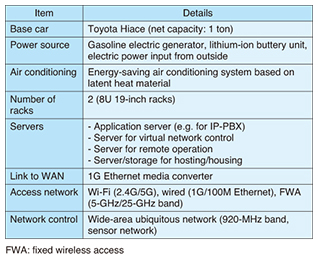 |
|||||||||||||||||||||
|
|
|||||||||||||||||||||
|
Feature Articles: Movable and Deployable ICT Resource Unit—Architecture for Quickly Responding to Unexpected ICT Demand Vol. 13, No. 5, pp. 1–6, May 2015. https://doi.org/10.53829/ntr201505fa1 Overview of Movable and Deployable ICT Resource Unit ArchitectureAbstractWhen the Great East Japan Earthquake struck in 2011, a lot of the information and communication technology (ICT) infrastructure suffered catastrophic damage, which triggered ICT service outages in various areas for long periods of time. NTT Network Innovation Laboratories has been working to solve this problem and has developed ICT architecture called the Movable and Deployable ICT Resource Unit (MDRU). This architecture enables us to instantly deliver ICT services in damaged areas by installing a transportable ICT unit that accommodates the equipment necessary for providing ICT services. This article presents an overview of the MDRU architecture and also introduces a research and development project launched to realize it. Keywords: resilient ICT, Wi-Fi, IP-PBX 1. IntroductionThe Great East Japan Earthquake struck on March 11, 2011 and caused catastrophic damage over a wide area of northeastern Japan due not only to the large tremor but also to the devastating tsunami that it triggered. Telecommunication companies and information and communication technology (ICT) service*1 providers also suffered serious damage to their network infrastructure. Because of the damage, they had to stop delivering ICT services in quite a few areas for a long time. At the same time, people in the damaged areas urgently needed ICT services in order to confirm the safety of their loved ones such as family members, relatives, friends, and neighbors, and to collect information on what was happening and what would happen next. This resulted in an explosion in the demand for ICT services. This large supply-and-demand gap in the ICT sector strongly reminded people of the importance of the ICT infrastructure and the necessity of service continuity even under extreme disasters. NTT Network Innovation Laboratories responded to the public’s expectations by proposing the resilient ICT architecture called the Movable and Deployable ICT Resource Unit (MDRU)*2 [1]. The MDRU architecture enables us to promptly reestablish ICT services in disaster-affected areas by installing transportable resource units that accommodate the functions necessary to deliver ICT services such as telephony and information sharing. These Feature Articles report on the MDRU architecture and the research and development (R&D) activities underway in NTT Network Innovation Laboratories. This article gives an overview of the MDRU architecture and explains the R&D projects launched to realize it. Subsequent articles report the major technologies used in the architecture, including those for Wi-Fi-based network configuration [2], high-speed optical-link establishment [3], efficient media storage and transmission [4], and convenient ICT service delivery [5]. The last article reports on a feasibility study of MDRU use in an area in the Philippines, which was affected by Typhoon Haiyan in 2013, as an example of a specific activity being conducted toward MDRU commercialization [6].
2. MDRU architectureThe concept of the MDRU architecture is shown in Fig. 1. An MDRU is a transportable unit accommodating the various resources necessary to deliver ICT services. Once a disaster occurs, one or more MDRUs are promptly transported to the disaster-affected area and set up there. Each unit then rapidly forms a Wi-Fi-based local area network (LAN) in its surrounding area and starts delivering at least basic ICT services to the people in the area. The MDRU is connected to the existing wide area network (WAN) via remaining optical fibers and/or satellite links. Once the MDRU is connected to the WAN, it acts as a local information hub.
After the earthquake struck in 2011, NTT deployed transportable systems such as switching systems, base-station systems, and satellite public telephone systems in an effort to respond to the disaster. The objective of using these systems was to repair the existing network infrastructure or to temporarily replace damaged portions of the infrastructure. Unfortunately, such systems took too long to install and activate, as a lot of work was needed such as to confirm the locations and degree of damage and to make system adjustments. The repairs were patchwork, and services lagged. It sometimes took as long as a few weeks to recover basic service. Moreover, it was not easy to flexibly respond to the unexpected demand that arose after the disaster such as when a large evacuation center was established in an unpredictable place. The MDRU architecture, on the other hand, is aimed at creating a new ICT service-delivery environment anytime, anywhere irrespective of the situation of the existing network infrastructure [7]. An MDRU forms a Wi-Fi-based LAN in its surrounding area and promptly delivers basic ICT services within the local area. The MDRU architecture enables us to flexibly and instantly deliver ICT services in any situation by optimizing the system configuration and by selecting the technologies that meet the current objectives. 3. Enabling technologies in MDRU architectureThe major enabling technologies adopted for the MDRU architecture are shown in Fig. 2. The MDRU actually acts as a movable telephone office and/or datacenter. It accommodates network equipment, servers, and storage devices. They are interconnected to form a LAN in the unit. The LAN is extended to the surrounding area by way of a Wi-Fi-based access network to reach customer devices such as smartphones and personal computers. In the server, application software for ICT services such as Internet protocol (IP)-based telephony is installed [8]. Several new technologies allow the MDRU to instantly respond to new demands for ICT services in the disaster-affected area. Details of the technologies are reported in the other Feature Articles in this issue.
4. MDRU R&D projectNTT Network Innovation Laboratories launched an R&D project aimed at realizing the MDRU architecture in collaboration with NTT Communications Corporation, Tohoku University, and Fujitsu Limited, and with the support of the Ministry of Internal affairs and Communications of Japan. The prototype MDRUs developed in the project are shown in Fig. 3. Several types of MDRUs that have different sizes and resource capabilities have been developed. The MDRUs have been subjected to several feasibility studies and proof-of-concept experiments such as those to confirm the operation of major functions.
The specifications of the latest prototype MDRU, which is a vehicle called the ICT Car, are summarized in Table 1. The ICT Car can deliver ICT services for five consecutive days without external electric power, as it hosts an electric power system consisting of a generator and batteries and an energy-saving air conditioning system based on latent heat material. The ICT Car carries several wireless equipment modules such as Wi-Fi access point equipment and wireless transceivers for fixed point-to-point wireless links. These wireless modules are distributed in the area surrounding the ICT Car and used to form the widest possible wireless access network.
5. MDRU installation experiment as a proof of conceptWe conducted an MDRU installation experiment using ICT Car at the University of Aizu in Fukushima Prefecture to prove our concept. Some pictures of the experiment are shown in Fig. 4. In Fig. 4(a), project members take the wireless modules from the ICT Car and prepare to distribute them. In Fig. 4(b), some project members are setting up a Wi-Fi access point module by connecting the module to its antenna.
The experimental results are shown in Fig. 5, which plots the relationship between the installation patterns of the wireless access network and the measured times necessary to start delivering a service. We experimentally confirmed that it was possible for us to start delivering ICT services within 40 minutes after the arrival of the ICT Car at the intended site. When the wireless access network was extended by a few kilometers by linking several wireless modules, it took about 140 minutes in total, regardless of the type of area extension. These times meet our MDRU requirement of delivering service within a few hours after arrival. Thus, we can conclude from the experiments and trials that the proposed MDRU architecture is highly effective.
6. Summary and future workThis article introduced the MDRU architecture, which was developed to resolve the critical issues appeared after the 2011 earthquake, and described several achievements of the MDRU R&D project. The feasibility of the proposed MDRU concept has already been confirmed, and the project is now moving toward the commercialization phase. Discussion of the global standardization of the MDRU architecture in ITU-T (International Telecommunication Union, Telecommunication Standardization Sector) SG (Study Group) 15 started in 2014. A feasibility study of our MDRU architecture in an actual disaster area has also been conducted in the Philippines, where MDRU sets were used to provide services to people in an area affected by a typhoon. There are other goals to be accomplished in the MDRU R&D project, so our R&D activities will continue. Our final goal is to apply MDRUs domestically as well as globally and to contribute to saving the lives of people in disaster areas in the future. AcknowledgementPart of the work in this article is being conducted under the national projects, R&D on the reconfigurable communication resource unit for disaster recovery and R&D of “Movable ICT Units” for emergency transportation into disaster-affected areas and multi-unit connection, both supported by the Ministry of Internal Affairs and Communications of Japan. References
|
|||||||||||||||||||||









